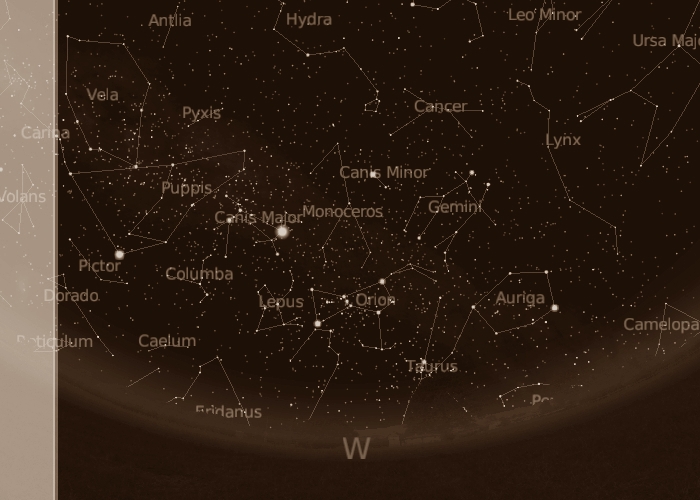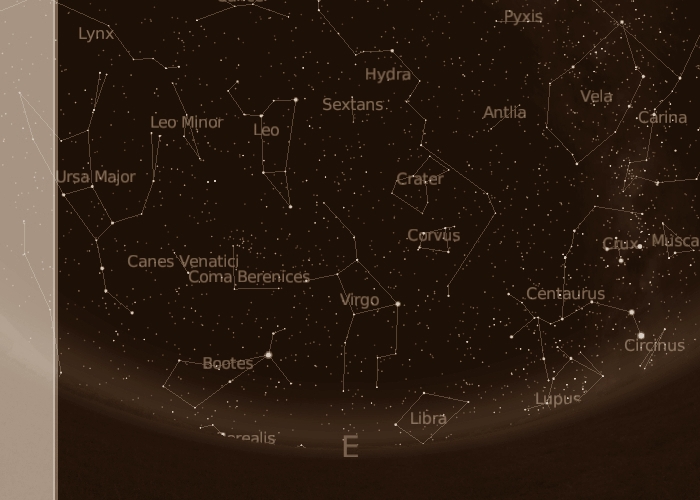Western Horizon
Eastern Horizon
![]()
Western Horizon
Eastern Horizon

We are reaching the end of the skies of the winter solstice, as, further, this month is home to the vernal equinox! Hence the skies we see are transitioning ones, passing from the winter solstice epoch to the spring equinox one! See how South, the constellations which had been born, in the 18th century, from the antique, large constellation Argo, the Ship, the ship of the Argonauts, have now gotten high, from Puppis, the Ship's Stern to Carina, the Ship's Keel. The bright star to their South is the famed Canopus. Crux, the Southern Cross is rising southeast, heralding what the skies of the vernal equinox will be. Fine views are provided further, West. Turn West! Orion, the Hunter which was high during last months, is now West. Orion is a large quadrilateral of stars, easy to spot with its three stars aligned -the 'Orion's Belt- in its center. Sirius -the sky's brightest star- and Canis Major, the Great Dog is to its upper left, as Gemini, the Twins are now to its upper right. The bright star, high, is Procyon, of Canis Minor, the Little Dog. The bright star and the constellation northwest are Capella and Auriga, the Charioteer. to a printer-friendly chart
West for the mid-northern latitudes. West for the mid-southern latitudes

As the southeastern part of the sky is the sky transitioning between the winter solstice and the vernal equinox, the two bright stars, still low, East, are Arcturus (left) and Spica (about East), respectively. Both those stars are famed due to an astronomical saying, which states: 'Arc to Arcturus, speed on to Spica'. This saying is showing how both stars are easy to find when one extends the arc of three stars which constitutes the Dipper's handle. The Great Dipper is this asterism -part of the constellation Ursa Major, the Great Bear- which is a distinctive feature of the skies in the northern hemisphere. It's currently seen northeast. Just follow the arc. It leads, first, to Arcturus. Then to Spica! Leo, the Lion, is now high, as, southeast, the long chain of Hydra, the Hydra is bound for the location it will have in the skies of the spring equinox. Three small constellations are anchoring along: Sextans, the Sextant, high, Crater, the Cup, and Corvus, the Crow. Coma Berenices, above Bootes, is a field of deep-sky galaxies. Another view of interest is seen on the northern horizon as the Great Dipper -which, like said, is the distinctive feature of the skies in the northern hemisphere- is seen along with its mother-constellation, Ursa Major, the Great Bear. A fine show! to a printer-friendly chart
East for the mid-northern latitudes. East for the mid-southern latitudes
(color maps with Stellarium; printer-friendly charts with Cartes du Ciel, Patrick Chevalley)
Website Manager: G. Guichard, site 'Amateur Astronomy,' http://stars5.6te.net. Page Editor: G. Guichard. last edited: 12/28/2010. contact us at ggwebsites@outlook.com